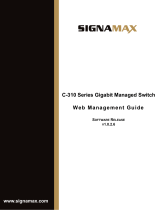
4 Contents
Single IP Management . . . . . . . . . . . . . . . 57
Automatic Firmware Update for New Stack
Members
. . . . . . . . . . . . . . . . . . . . . . 57
Stacking Compatibility with the PowerConnect
M6348
. . . . . . . . . . . . . . . . . . . . . . . . 57
Master Failover with Transparent Transition . . . . 58
Nonstop Forwarding on the Stack . . . . . . . . . 58
Hot Add/Delete and Firmware Synchronization . . 58
Security Features . . . . . . . . . . . . . . . . . . . . 58
Configurable Access and Authentication
Profiles
. . . . . . . . . . . . . . . . . . . . . . . 58
Password-Protected Management Access
. . . . 59
Strong Password Enforcement . . . . . . . . . . . 59
TACACS+ Client . . . . . . . . . . . . . . . . . . . 59
RADIUS Support
. . . . . . . . . . . . . . . . . . 59
SSH/SSL. . . . . . . . . . . . . . . . . . . . . . . 60
Inbound Telnet Control . . . . . . . . . . . . . . . 60
Denial of Service
. . . . . . . . . . . . . . . . . . 60
Port Protection . . . . . . . . . . . . . . . . . . . 60
Captive Portal . . . . . . . . . . . . . . . . . . . . 61
Dot1x Authentication (IEEE 802.1X)
. . . . . . . . . 61
MAC-Based 802.1X Authentication . . . . . . . . . 61
Dot1x Monitor Mode . . . . . . . . . . . . . . . . 62
MAC-Based Port Security
. . . . . . . . . . . . . 62
Access Control Lists (ACL) . . . . . . . . . . . . . 62
Time-Based ACLs
. . . . . . . . . . . . . . . . . . 63
IP Source Guard (IPSG)
. . . . . . . . . . . . . . . 63
DHCP Snooping . . . . . . . . . . . . . . . . . . . 63
Dynamic ARP Inspection . . . . . . . . . . . . . . 63
Protected Ports (Private VLAN Edge)
. . . . . . . . 64
Green Technology Features
. . . . . . . . . . . . . . . 65
Energy Detect Mode
. . . . . . . . . . . . . . . . 65
Energy Efficient Ethernet
. . . . . . . . . . . . . . 65





















